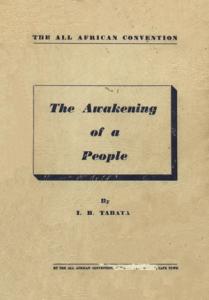Related Collections from the Archive
Related content
When The Awakening of A People was first published in 1950, it was intended for the clarification of the real issues facing the Black masses of South Africa and serve as a guide to action. There is in existence a considerable body of literature, books, pamphlets, speeches, polemics, that was created in the course of the early campaigns of the liberatory movement in South Africa from the early forties to the sixties; for the battle of ideas was at the same time a focal point amongst the intellectuals. Tabata was one of a militant vanguard that entered the national struggle of the Blacks at a time when the upheavals preceding the second inter-imperialist world war were quickening liberatory ideas amongst the oppressed of many countries.
It is clear from the way this militant vanguard posed the fundamental tasks and problems of the struggle, the necessity for the people first to understand the exact nature of South African society and the forces of oppression, that they grasped the dynamic of an unfolding revolutionary process in South Africa. The Awakening of a People at once records in detail and epitomises the outlook and activities of the militant vanguard and its impact on the people, marking a turning-point in the history of the struggle by setting it on an independent road. It analyses new concepts and methods of struggle; how they rejected reliance on any section of the ruling-class to "help" the oppressed Blacks; how they based their plan of action on the recognition that in South Africa, a capitalist society, the basic struggle is a class struggle where oppressor and oppressed are in irreconcilable conflict. They exposed racialism, not only between the Blacks and the small white aristocracy of labour but also between Africans, Coloureds and Indians, as a function of class exploitation. The struggle of all the Blacks (they argued) was not to be spent in protesting against this or that racial law, or seeking concessions from the Government. No one section could liberate itself at the expense of another. The struggle is for the overthrow of the whole exploitive system that holds them all in chains. Above all - at the very core of their argument - unity is essential to the waging of what must be a protracted struggle against oppressors who practice every device of "divide and rule".
When the Africans, the majority section of the Blacks, had been confronted in 1936 with three Slave Bills devised by a Fusion Government of Hertzog-Smuts to deprive them of the very last vestige of political rights, they came together for the first time in their history, uniting all African organisations in a fighting body totally rejecting the Bills. The oldest organisation, the African National Congress, was also a member. Its conservative leaders, however, who were strongly attached by tradition to the white liberal bourgeoisie, were persuaded to compromise with the Government and virtually betrayed the decisions of a united people by agreeing to "give the Acts a trial". They had proceeded to run dummy (segregated) elections under the fraudulent "Native Representation Act" whereby three white judas-goats (as they were called)represented the African masses in a whites-only parliament of 150. One of the first tasks of the militant vanguard had been the regeneration of the All-African Convention. Assessing its political potential, Tabata writes: "This form of organisation, uniting a whole people, cleared the way for a national outlook, the logical outcome of this particular stage of development." And such an outlook "constitutes the first stage of a threat to white domination."
His book records how in 1943 the All-African Convention issued a call for a still wider unity, the unity of all sections of the Blacks. But the African National Congress, whose conservative leaders had withdrawn all their branches from the Convention, refused to join this unity. So did the main bodies of the South African Indian Congress, dominated as it was by the merchant class, whose stated policy was one of compromise with the Smuts Government.
